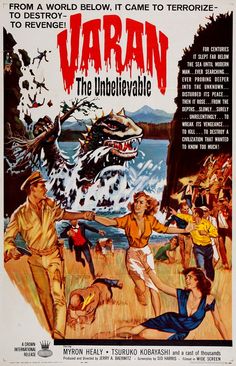“Varan the Unbelievable” was an American-produced adaptation of the material, similar to the American adaptation of the original Godzilla (Gojira, 1954). Varan was originally to be a joint US/Japanese production, but that deal fell through. Toho, the Japanese production company, went ahead and did Varan anyway, and a few years later, the American version was produced, with a different title and with additional material directed by Jerry A. Baerwitz. It doesn’t help the confusion that Tokyo Shock decided to release their DVD under the American title of “Varan the Unbelievable”, but surely that was done because that’s the title that Americans know the film under.
How do you know what version you watched? Well, the American version has an American actor, Myron Healey, and a plot about trying to desalinize water. It’s also only 70 minutes long. The Japanese film is about 90 minutes long, has no American actors, and Varan (or “Baran”) makes his first (offscreen) appearance when scientists from Tokyo make a trip to a remote, mountainous village to research the sighting of a butterfly previously only known to exist in Siberia. The Japanese version also has a different musical score, but since music is a bit difficult to describe well in words (other than technically), that’s not a great way for most folks to tell which version they’ve watched.
To make matters even more confusing, the Tokyo Shock DVD has a truncated Japanese television version of Daikaijû Baran, clocking in at about 50 minutes, which dispenses with both the desalinization and the butterfly plots. Also, at least some people have reported seeing a color version of the film. I don’t know which version that would be, but the Tokyo Shock DVD has the original, black & white widescreen Japanese version from 1958. I would have much preferred if Tokyo Shock would have put the American adaptation of Varan on the DVD as an extra, as the Japanese television version is just the same film with a bunch of edits for time and there are a few scenes rearranged to try to create something more coherent given the cuts. Tokyo Shock probably didn’t put the American film as an extra because of some licensing or royalty issue. I can also imagine Toho objecting to it. Note that there’s a good commentary track for the film with Murase Keizo, who was in charge of special effects models on the film (he’s not credited on either IMDb listing).

